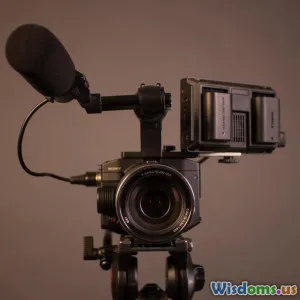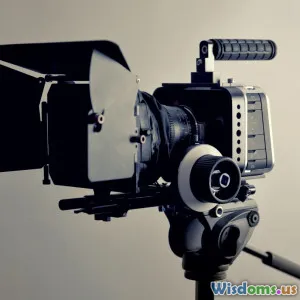
Ultimate Comparison Voiceover Scripts Versus On Camera Scripts
8 min read Explore the distinct nuances between voiceover and on-camera scripts to optimize your video content strategy effectively. (0 Reviews)
Ultimate Comparison: Voiceover Scripts Versus On-Camera Scripts
Introduction
Imagine watching two video advertisements: one where a confident speaker addresses you directly, engaging through facial expressions and gestures; the other fades from stunning visuals accompanied by a calm, narrating voice guiding your journey. The driving force behind each is the script — but not just any script. These are tailored scripts designed specifically for voiceover or on-camera use. Understanding their differences is essential for content creators, marketers, and filmmakers alike who want to harness the best communication strategy for their unique goals.
This article dives deep into the ultimate comparison between voiceover scripts and on-camera scripts. We will dissect their distinct purposes, writing techniques, challenges, and performance differences, all supported by real examples and expert insights. By the end, you’ll gain clarity on how to craft and utilize these scripts to maximize your content’s impact.
1. Understanding the Two Scripts: Definitions and Contexts
What is a Voiceover Script?
A voiceover script is specially crafted for off-screen narration. The script accompanies visuals without a visible speaker—think explainer videos, documentary narration, radio ads, or animated characters' dialogues. The voiceover guides the audience's understanding or emotional response without relying on visual cues from a live presenter.
Example: According to a Nielsen Norman Group study, voiceover narration helps viewers grasp complex data in explainer videos when paired with clean visuals, making information easier to digest.
What is an On-Camera Script?
On-camera scripts are designed to be performed by a speaker appearing directly to the audience. This is common in news anchors, tutorial videos, product demos, or personal vlogs where body language, facial expressions, and eye contact enrich communication.
Real-World Insight: Television producers emphasize the use of "natural language" in on-camera scripts to maintain authenticity, as awkward or overly formal scripts reduce viewer trust and engagement.
2. Core Differences in Purpose and Delivery
Voiceover: Supporting Visuals Without Visibility
Voiceover scripts emphasize:
- Clarity and conciseness to complement visuals without competing for attention.
- Vivid descriptions to evoke imagery in place of a physical presence.
- Controlled pacing since the speaker’s tone, pauses, and inflections must align with the timing of visuals.
Example: Consider the Academy Award-winning documentary "March of the Penguins" where narration enhances emotional storytelling without direct presenter involvement.
On-Camera Scripts: Engaging Through Personality
On-camera delivery leverages:
- Conversational tone to foster connection.
- Scripts that leave breathing room for natural facial expressions, smiles, or emphasis.
- Allows improvisation or adaptions on a per-take basis.
Billy Maher, a video marketing specialist, states, "On-camera scripts need to feel like a warm conversation rather than a rehearsed speech. This authenticity creates stronger viewer trust."
3. Writing Techniques and Structural Differences
Structure of Voiceover Scripts
Voiceover scripts often:
- Use clear signposting to orient the viewer.
- Incorporate fewer filler words to maintain professional flow.
- Are tightly timed to fit precise video durations, sometimes down to milliseconds.
For example, an explainer video for a tech product may allot 15 seconds for what the product does, and the voiceover must deliver that information crisply to avoid overshooting or lagging.
Structure of On-Camera Scripts
On-camera scripts might:
- Include prompts for gestures or pauses to emphasize points.
- Use simpler, more colloquial language to sound natural.
- Balance script length with the speaker’s comfort and charisma—for instance, Alexander Newman, a presenter coach, recommends scripts that allow room for micro-improvisations to retain spontaneity.
4. Performance Considerations: Challenges and Opportunities
Challenges in Voiceover
- Lack of visual persona means the voice carries the entire emotional weight.
- Voice actors must modulate tone meticulously, sometimes managing multiple characters.
According to a Voice Acting Academy survey, 72% of voice actors cite script pacing as the top challenge, requiring careful synchronization with visual cues.
Challenges in On-Camera Scripts
- Speakers must manage both voice and body language naturally.
- Technical aspects such as makeup, lighting, and camera angles add complexity beyond just the script.
Jeffrey Scott, a renowned screenwriter, advises scripting "naturalistic dialogue" but practicing extensively to avoid stiffness on camera.
5. Practical Examples and How to Choose the Right Script for Your Project
Scenario 1: Educational Content
- Voiceover allows clear focus on graphics and demos.
- On-camera builds personal connection complex topics requiring empathy.
A Khan Academy style video primarily uses voiceover, while TED Talks often rely on on-camera scripts for dynamic delivery.
Scenario 2: Marketing Videos
- Explainer videos and product walkthroughs generally benefit from voiceovers to maintain polish.
- Testimonials and brand ambassadors excel with on-camera scripts for authenticity.
Scenario 3: Entertainment
- Animated films use voiceover scripts extensively to match characters.
- Live interviews and reality content rely solely on on-camera scripts.
Conclusion
Choosing between voiceover and on-camera scripts isn’t about one being inherently better than the other—it's about strategy, context, and audience. Voiceover scripts serve to guide through unseen narration where the voice is an unseen storyteller. In contrast, on-camera scripts bring intimacy, trust, and personal connection by making the speaker visible and relatable.
Content creators must understand these nuances to tailor their scripts effectively, ensuring maximum engagement and message clarity. Whether shaping a breakthrough explainer video or crafting an inspiring personal vlog, recognizing how to write and deliver these distinct types will elevate your storytelling craft.
Explore your content’s needs carefully, and you’ll harness the full power of both voices—spoken and seen.
Written by [Your Name], content specialist in digital storytelling and media strategy.
Rate the Post
User Reviews
Popular Posts




















